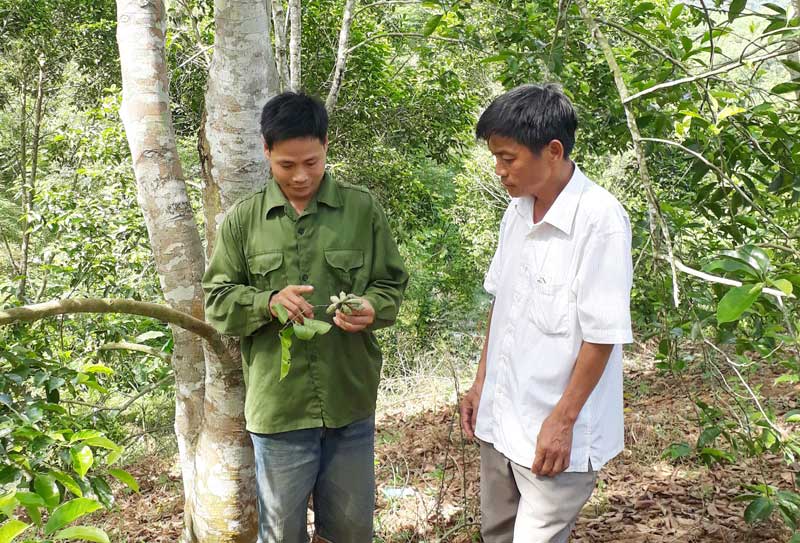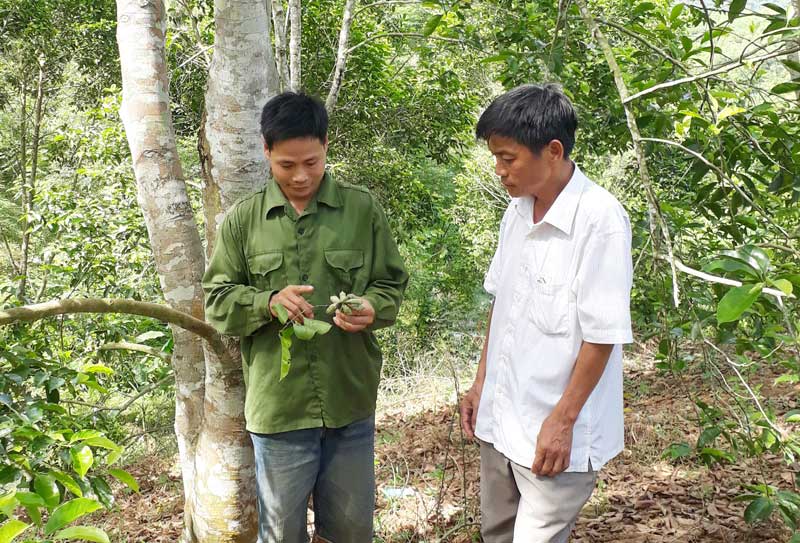
(HBO) – Previously, it took farmers in Lac Son district, Hoa Binh province, at least 7-8 years to take care of Doi trees (michelia tonkinensis) before harvesting their nuts which are used as a spice. Now, the technique of graft helps halve the time and opens up a new promising way of growing Doi trees for Quach Phien in Chieng hamlet, Phuc Tuy commune, Lac Son district.
A Doi garden is located on Roc Trau
hill,
500 metresfar away from the local residential area. With branches bearing with rich
fruits, we can’t believe the Doi trees in the garden are in the fourth year.
"We used to plant maize and cassava. Acacia trees also take a long time while
the profit was low, therefore I used to work far from home”, Phien said.

Grafting Doi trees opens up a new way to get rich for Quach Phien (L) in
Chieng hamlet, Phuc Tuy commune, Lac Son district.
It takes just three or four years for
grafted Doi trees to produce fruits while the traditional way takes seven or
eight years. This is a promising way, Phien said, adding that he learnt to
graft Doi trees by himself, with the successful rate now reaching 80 percent.
Fifty grafted Doi trees, which were planted
four years ago, are developing well. The land here is fertile and suitable for
growing Doi trees. They have flowers and fruits right in the third year. Last
year, Phien sold fresh Doi nuts at 600,000 VND (24 USD) per kilogramme, and
dried Doi nuts at 2 million VND (88 USD) per kilogramme, earning over 100
million VND (4,400 USD) from his garden. This year, the trees bear plentiful
fruits, and promise a same value, Phien said.
The Doi trees are developing well
among the Acacia forest. Phien is excited when talking about his Doi trees,
though he regretted for planting them a little too thick. Doi trees should be
planted seven metres away from each other to enable their branches to stretch,
Phien said, adding that he has planted an additional 300 grafted Doi trees and targets
to plant 500 trees this year.
To ensure the quality of grafted Doi
trees, Phien had to select those with many fruits and good development to graft
with other trees. His 50 four-year-old Doi trees offer a huge source. Seeing
his success, many local residents bought seedlings from Phien and now have also
well-developed Doi gardens. Phien plans to expand his Doi garden to supply for
the market.
Besides Doi nuts, Phien also raises
chickens in the garden and earns a stable income. Grafting Doi trees has opened
up a new way for Phien to get rich right in his homeland. This is a promising
livelihood for local residents as many have learnt from Quach Phien to shift
their mixed gardens to Doi trees.
According to data from the Hoa Binh Provincial Party Committee, the industrial production index for the first six months of 2025 is estimated to have increased by 20% compared to the same period last year. This marks the highest year-on-year growth rate for this period since 2020.
In the first six months of 2025, Hoa Binh province’s export turnover was estimated at 1.145 billion USD, marking an 18.11% increase compared to the same period in 2024. Import turnover was estimated at $ 804 million, a 17.15% increase, which helped the province maintain a positive trade balance.
The lives of the ethnic minority farmers in Tan Lac district have gradually improved thanks to the new directions in agricultural production. This is a testament to the collective strength fostered through the professional associations and groups implemented by various levels of the district’s Farmers’ Union.
With the motto the "product quality comes first,” after nearly one year of establishment and operation, Muong village’s Clean Food Agricultural and Commercial Cooperative, located in Cau Hamlet, Hung Son Commune (Kim Boi district), has launched reputable, high-quality agricultural products to the market that are well-received by consumers. The products such as Muong village’s pork sausage, salt-cured chicken, and salt-cured pork hocks have gradually carved out a place in the market and they are on the path to obtaining the OCOP certification.
In the past, the phrase "bumper harvest, rock-bottom prices" was a familiar refrain for Vietnamese farmers engaged in fragmented, small-scale agriculture. But today, a new spirit is emerging across rural areas of Hoa Binh province - one of collaboration, organisation, and collective economic models that provide a stable foundation for production.
Maintaining growing area codes and packing facility codes in accordance with regulations is a mandatory requirement for agricultural products to be eligible for export. Recently, the Department of Agriculture and Environment of Hoa Binh province has intensified technical supervision of designated farming areas and packing facilities to safeguard the "green passport" that enables its products to access international markets.



